We Will Not Forget
A Day of Terror
September 11th, 2001 dawned in New York as a crystal clear day - a
perfect day. Throughout the city, Stationary Engineers were readying
their buildings for the Tuesday morning influx of tenants. Everything
and everyone was at the city's normal hastened pace. None knew that
within just a few hours, their city and the lives of everyone within
would never again be the same.
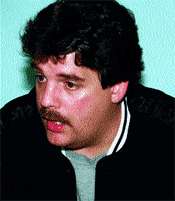 Mike
Pecoraro helped hundreds to escape only to find himself trapped and staring
death in the face. Mike
Pecoraro helped hundreds to escape only to find himself trapped and staring
death in the face.
Mike Pecoraro had gotten up from bed at 4 a.m. to make his normal 2
hour commute from his Long Island home to the World Trade Center,
where he worked as a Stationary Engineer on a roving crew that serviced
all of the buildings at the com plex. The 36 year-old father of two
stopped and bought breakfast on the way into One World Trade Center
and changed into his work clothes. At about 6:45 he went to the mechanical
shop in the second subbasement, ate his breakfast and chatted with
his co-workers who were also arriving for the normal 8:00 a.m. beginning
of their shift. Mike's assignment that day would be to continue constructing
a gantry that would be used to pull the heads from the 2,500 ton
chillers, located in the 6th sub- basement level of the tower. 49,000
tons of refrigeration equipment were located in the lower level of
the tower. The 2,500 ton units were the smallest in use.
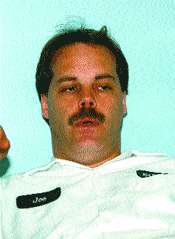 Joe
Shearin managed to override an overhead garage door mechanism, saving
trapped occupants from certain death. Joe
Shearin managed to override an overhead garage door mechanism, saving
trapped occupants from certain death.
Donning his hearing protection, respirator, gloves and eye protection,
Mike, along with another engineer, began the work day using a large
grinder to smooth down the welds on steel they were using for the gantry.
Deep underground, in an area surrounded by solid bedrock, the noise
made by the grinder reverberated from the walls as sparks flew from
the spinning grinding wheel.
 Tom
Hart reaches out even today to assist survivors deeply hurt by the World
Trade Center attack. Tom
Hart reaches out even today to assist survivors deeply hurt by the World
Trade Center attack.
High above in the management office, on the 88th floor of the tower,
John Griffin, Jr., the father of two and the new Director of Operations
at the World Trade Center, was also beginning his day. John had been
hired by the buildings' owners, Silverstein Company, just two months
earlier. The son of an Engineer, John seemed born to the job and
by all account was more than capable of shouldering the challenge
of running one of the largest buildings in the
world. John worked with Charles "Charlie" Magee, the Chief Engineer
at the Center. Along with the 35 other employees who made up the management
staff of the World Trade Center, they began their day high above the
bustling city, managing what was a city within the city.
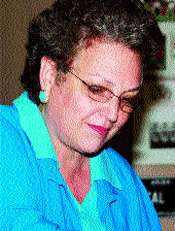 Paula
Daly works each day to help survivors suffering the emotional trauma
of September 11th. Paula
Daly works each day to help survivors suffering the emotional trauma
of September 11th.
Joe Shearin, the 36 year-old Assistant Chief Engineer at the World
Trade Center, began his day by distributing work orders to his crew.
The father of a 2 year-old daughter, Joe loved nothing more than the
work he did and the place he worked. His best friend, Vito Deleo, another
Stationary Engineer, worked with him. The two were all but inseparable.
They worked together almost every day. It was generally accepted by
all who worked on the
maintenance staff that if they saw one, the other had to be close by.
 Mike
Carney, President and Business Manager of IUOE Local 94, continues to
lead his Local through its darkest hour. Mike
Carney, President and Business Manager of IUOE Local 94, continues to
lead his Local through its darkest hour.
That morning a note had been left for Joe by the Chief Engineer of
the midnight to 8 a.m. shift telling him that a tenant on the 38th
floor wanted to see him as early as possible. So after distributing
the work orders to his staff, he entered one of the tower's elevator
cars and headed up into the building.
_______________________________
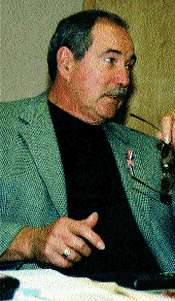 John
Griffin, Sr. sadly related the final moments of his son's life to the Chief
Engineer. John
Griffin, Sr. sadly related the final moments of his son's life to the Chief
Engineer.
Deep below the tower, Mike Pecoraro was suddenly interrupted in his
grinding task by a shake on his shoulder from his co-worker. "Did
you see that?" he was asked. Mike told him that he had seen nothing. "You
didn't see the lights flicker?", his co-worker asked again. "No," Mike
responded, but he knew immediately that if the lights had flickered,
it could spell trouble. A power surge or interruption could play
havoc with the building's equipment. If all the pumps trip out or
pulse meters trip, it could make for a very long day bringing the
entire center's equipment back on-line.
 September
11, 2001, two hijacked commercial aircraft are flown into the World Trade
Center towers. September
11, 2001, two hijacked commercial aircraft are flown into the World Trade
Center towers.
Mike told his co-worker to call upstairs to their Assistant Chief
Engineer and find out if everything was all right. His co-worker made
the call and reported back to Mike that he was told that the Assistant
Chief did not know what happened but that the whole building seemed
to shake and there was a loud explosion. They had been told to stay
where they were and "sit tight" until the Assistant Chief got back
to them. By this time, however, the room they were working in began
to fill with a white smoke. "We smelled kerosene," Mike recalled, "I
was thinking maybe a car fire was upstairs", referring to the parking
garage located below grade in the tower but above the deep space where
they were working.
 John
McGinley, an Engineer at the WTC was on the 56th floor of Building 2
when the attack occurred. Today he has trouble working in buildings taller
than ten stories. John
McGinley, an Engineer at the WTC was on the 56th floor of Building 2
when the attack occurred. Today he has trouble working in buildings taller
than ten stories.
The two decided to ascend the stairs to the C level, to a small machine
shop where Vito Deleo and David Williams were supposed to be working.
When the two arrived at the C level, they found the machine shop gone.
"There was nothing there but rubble, "Mike said. "We're talking about
a 50 ton hydraulic press ? gone!" The two began yelling for their co-workers,
but there was no answer. They saw a perfect line of smoke streaming
through the air. "You could stand here," he said, "and two inches over
you couldn't breathe. We couldn't see through the smoke so we started
screaming." But there was still no answer.
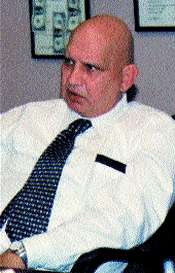 Sergei
Siletzky was a helper at WTC. At the time of the attack, he was attending
class at Local 94. Sergei
Siletzky was a helper at WTC. At the time of the attack, he was attending
class at Local 94.
The two made their way to the parking garage, but found that it,
too, was gone. "There were no walls, there was rubble on the floor,
and you can't see anything" he said.
They decided to ascend two more levels to the building's lobby. As
they ascended to the B Level, one floor above, they were astonished
to see a steel and concrete fire door that weighed about 300 pounds,
wrinkled up "like a piece of aluminum foil" and lying on the floor. "They
got us again," Mike told his co-worker, referring to the terrorist
attack at the center in 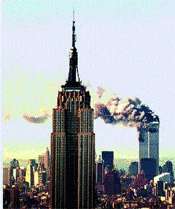 1993.
Having been through that bombing, Mike recalled seeing similar things
happen to the building's structure. He was convinced a bomb had gone
off in the building. Mike walked through the open doorway and found
two people lying on the floor. One was a female Carpenter and the other
an Elevator Operator. They were both badly burned and injured. Realizing
he had to get help, Mike ascended to the Lobby Level where he met Arti
DelBianco, a member of his work crew. People were now coming down the
same stairway from above the lobby and Arti and Mike had to stay where
they were to direct people out of the stairway door and into the building's
lobby. If they didn't, people descending could walk past the lobby
door and unwittingly keep descending into the sublevels of the building. 1993.
Having been through that bombing, Mike recalled seeing similar things
happen to the building's structure. He was convinced a bomb had gone
off in the building. Mike walked through the open doorway and found
two people lying on the floor. One was a female Carpenter and the other
an Elevator Operator. They were both badly burned and injured. Realizing
he had to get help, Mike ascended to the Lobby Level where he met Arti
DelBianco, a member of his work crew. People were now coming down the
same stairway from above the lobby and Arti and Mike had to stay where
they were to direct people out of the stairway door and into the building's
lobby. If they didn't, people descending could walk past the lobby
door and unwittingly keep descending into the sublevels of the building.
 Gerard
Tate, an engineer who rushed to the World Trade Center, discovered trapped
firefighters in the ruins and summoned the help which saved their lives. Gerard
Tate, an engineer who rushed to the World Trade Center, discovered trapped
firefighters in the ruins and summoned the help which saved their lives.
On the 38th floor, Joe Shearin exited the elevator and began his walk
down the hallway to meet with the tenant who had requested to see him.
About 50 feet down the hallway, he heard a loud explosion and was lifted
into the air. "I can't even tell you how far I traveled," he recalled.
When he landed, people were already coming out of their offices into
the hallway. "They were screaming, hollering," he said. "They were
asking what they should do and where they should go". Joe directed
them down the stairwells and out of the building.
 Kuba
Brown, Assistant Business Manager of Local 94, directed the union's response
in the initial hours following the World Trade Center attack. Kuba
Brown, Assistant Business Manager of Local 94, directed the union's response
in the initial hours following the World Trade Center attack.
What Joe first believed was that an equipment room on the 43rd floor,
which had an electrical substation, had blown up. He proceeded up the
5 floors to that level. Upon reaching the 43rd floor, "there were patches
of ceiling that was just down on the floor, water pipes were broken,
water was gushing like a brook or river that was just running down
the corridor of the machine room". He began yelling to see if anyone
was in the room and received no reply.
He made his way to one of the tower's stairways and began the walk
down to the lobby. "When I came down the stairwell (to the lobby level)
and I looked toward West Street, I just couldn't believe what I saw," he
recalled. "There was glass and people cut, covered in blood".
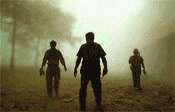 Stunned
by the sudden collapse of the towers, survivors made their way to safety
through an enormous dest cloud. Stunned
by the sudden collapse of the towers, survivors made their way to safety
through an enormous dest cloud.
Making his way out of the building, he found debris falling from
the top of the building. Still not understanding or knowing what had
happened, he made his way back to re-enter the building. As he went
around the west wall he saw two people. "They were pretty?I never seen
anything like that before," he said, his voice choking from the pain
of seeing it again in his memory. "This individual, she was that badly
burned, but she was still alive," he managed.
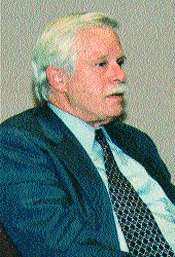 James
Berg, who represents employers on the Local 94 Board, came immediately
to the aid of members impacted by the attack. James
Berg, who represents employers on the Local 94 Board, came immediately
to the aid of members impacted by the attack.
In the Management Office on the 88th floor, the scope of the catastrophe
was more evident. John Griffin Jr. and Charlie Magee also thought at
first that an electrical substation had blown up. The force of the
explosion lifted furnishing into the air. One desk had flown up and
landed five feet away. The falling debris and furnishings blocked access
to the stairwells. The room began to fill with smoke. John, Charlie
and others began to break out windows to get air into the room.
 Peter
Pizzo, an engineer for Lee Technologies near the WTC, laid on his back
on the roof of his building for two and one-half hours keeping condenser
coils from clogging and jeopardizing the hi-tech equipment inside the
facility. Peter
Pizzo, an engineer for Lee Technologies near the WTC, laid on his back
on the roof of his building for two and one-half hours keeping condenser
coils from clogging and jeopardizing the hi-tech equipment inside the
facility.
They realized they had to escape and managed to clear a way to a
stairwell. They made certain that they had all the occupants from the
floor together and then began the long descent down the stairwell.
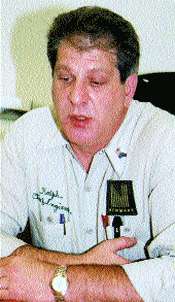 Ralph
Urizzo, an engineer and National Guard member, was activated and sent
to the World Trade Center on September 11th. Ralph
Urizzo, an engineer and National Guard member, was activated and sent
to the World Trade Center on September 11th.
On the way down the stairwell, John kept talking to his co-workers,
keeping them calm as they made their way down. They began to meet firemen
coming up the stairs, so some congestion started within the stairwell.
At each level, other building occupants were streaming into the stairwell
and the group of 35 from the Management office became separated by
the mass of people trying to leave the building.
No one ever saw John Griffin Jr. or Charlie Magee after that. If they
did make it to the first floor, they would have immediately joined
the fire command personnel. They would not have left the building.
All that was ever recovered of John Griffin Jr. was one credit card,
bearing his name.
 Raymond
Macco, Delegate for Local 94, helped to account for some of the 150 engineers
initially missing after the attack. Raymond
Macco, Delegate for Local 94, helped to account for some of the 150 engineers
initially missing after the attack.
______________________
Mike and Arti stayed in the stairwell at the first floor
of the tower directing people through the doors. People flooded the
stairwell and a great amount of water was also streaming steadily down
the stairs. Describing the people coming down Mike said: "Some were
burnt, some cut, some screaming, some fine; like there was nothing
going on".
"Literally thousands of people came by us down those stairs," Mike said. At one
point, an engineer had to run down the stairs to bring some tenants who had inadvertently
passed the first floor, back up to the lobby level.
The smoke in the stairwell was constant and at one point, Mike told
Arti that he was going to catch a quick breath of fresh air. He walked
out into the main lobby of the building, seeing it for the first time.
"When I walked out into the lobby, it was incredible," he recalled. "The whole
lobby was soot and black, elevator doors were missing. The marble was missing
off some of the walls. 20-foot section of marble, 20 by 10 foot sections of marble,
gone from the walls". The west windows were all gone. They were missing. These
are tremendous windows. They were just gone. Broken glass everywhere, the revolving
doors were all broken and their glass was gone. Every sprinkler head was going
off. I am thinking to myself, how are these sprinkler heads going off? It takes
a lot of heat to set off a sprinkler head. It never dawned on me that there was
a giant fireball that came through the air of the lobby. I never knew that until
later on. The jet fuel actually came down the elevator shaft, blew off all the
(elevator) doors and flames rolled through the lobby. That explained all the
burnt people and why everything was sooted in the lobby."
Spotting someone from the New York Port Authority, Mike asked him what
had happened. He told Mike that a helicopter had struck the building.
Mike immediately thought the helicopter must have struck at or near
the lobby level. He made his way back to the stairwell and told Arti
what he had found.
"Arti, I think we better get out of here," Mike recalled telling him. "If something
falls on us here, we are done."
They decided to try and re-group with the other Engineers and together
left the stairwell. There were hundreds of firemen on the scene by
then. "Everything was chaotic," he said. "People were running in every
direction. People were on the mezzanine. The second floor had a ledge
that went all the way around the inside of the building's lobby. It
was packed with people that were coming out of all the other stairwells".
 Brian
Muller, an engineer in Building 4 of the World Trade Center, was left
with deep emotional scars from his experience. Brian
Muller, an engineer in Building 4 of the World Trade Center, was left
with deep emotional scars from his experience.
Joe Shearin had managed to make his way on to West Street where he
met an Emergency Medical truck that had just pulled up. He asked the
technician if he could help the burned women he had seen and the technician
told him to help by carrying equipment into the tower. Joe filled his
arms and accompanied the technician into the building and stayed with
them, and helped take the woman to the ambulance outside.
Upon re-entering the building, Joe started to hear a rumbling sound. "I
knew what was happening," he said. "That was Two World Trade Center
starting to come down". He entered one of the elevators that serviced
the lobby floor and below and rode it down to where the mechanical
shop office was located. His plan was to make certain everyone he worked
with was out of the building and then exit the building through the
parking garage.
Entering the mechanical shop office, he found two people inside and
yelled for them to get out. He then went to the parking garage and
towards the doors that led out to West Street.
"I could see people up against the rollup doors, banging on the doors and stuff
like that". Seeing his building uniform, they yelled at Joe to help open the
door. Joe moved quickly to the door operating mechanism and managed to put it
into manual mode. Opening the door, they all fled into the air above as 2 World
Trade Center crashed down around them.
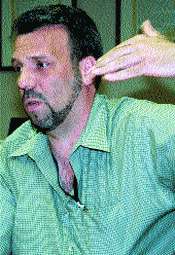 Nicholas
Lanzillotto, Chief Engineer for Merril Lynch at the World Financial Center,
safely evacuated his building then worked 24-hour shifts to bring his
building back into service. Nicholas
Lanzillotto, Chief Engineer for Merril Lynch at the World Financial Center,
safely evacuated his building then worked 24-hour shifts to bring his
building back into service.
Mike Pecoraro and Arti made their way out of Tower One and went to
Tower Two. They encountered a crowd of people standing outside the
tower, not knowing what had happened. Apparently, they had witnessed
a fireball come through the lobby after the second airplane had struck
that tower, but they were entering directly from the subway underground
and had as yet, no idea of what was happening. Mike and Arti told them
all to leave and go home. They then made their way to 4 World Trade
Center where they encountered a guard who initially was refusing to
leave her post. "Just go home," Mike told her. "You don't have a job,
it's done". Reluctantly, the guard left and walked towards the north
side of the complex.
Still believing that a helicopter had struck the tower, Mike finally
learned the truth when two female police officers informed him of the
jetliners. Feeling that they were not doing enough, the two decided
to go back to One World Trade Center to see what they could do to help
and to take another look in the 4th subbasement for Vito Deleo and
David Williams.
A search of the subbasements again turned up no one. The building at
this point almost seemed empty. A telephone was ringing in one of the
shops. Mike answered it and found a tenant on the other end requesting
that the heat be turned off in their office.
"I just shook my head and hung the phone up," he said. He wanted to call his
wife and tell her that he was okay, but could not get through on the line. He
finally managed to reach his wife's employer and asked her to relay a message
to his wife that he was all right.
Mike and Arti then decided to make their way to the Pump House which
was located away from the buildings at the far end of the complex.
The World Trade Center used water from the river for their condenser
needs. This water was pumped through a 60 inch main, fed by large pumps
located in the Pump House, near the river. Their walk there would take
them again through 2 World Trade Center.
No sooner had the two reached Tower 2 when Mike stopped and turned
to Arti. "I have a bad feeling," he told Arti. " I don't know what's
in there, but I know what's back there," he said indicating Tower 1
where they were. The two decided to go back to 1 World Trade Center,
cut through the lobby and make their way around the complex using a
different, longer route to the Pump House.
When they re-entered Tower 1, they saw more people coming down the
same stairwell where they had earlier been assisting. "They were more
hurt, more burnt, more tired," he said. They helped them exit the building
asking each if there was anyone up the stairs that needed assistance. "We'll
just run up and we'll grab them and get them out," he told them. But
each person reported that there was no one in the stairwell that they
had passed. Finally, a Port Authority worker descended the stairwell.
They asked him if there was anyone left up in the building. The man
said nothing, just shook his head and exited the building.
Mike and Arti decided it was time to leave as well. They left the stairwell
and re-entered the lobby. As they walked to the exit, they heard a
roar and the floor began to shake.
"Banging so hard that we fell down on our knees," he said. "I'm looking south,
at the building, Arti's looking at me, we locked eyes and he is screaming at
the top of his lungs...I can barely hear this guy. He's screaming, "What the
f? is that?", and I am screaming back at him, that I think it's another plane".
In reality, as the two were kneeling in the lobby of 1 World Trade
Center, its sister building, 2 World Trade Center, was crashing down
upon them.
"The building was just bouncing and bouncing, the floor was bouncing. I figured
another plane already hit the building". Mike related. "I'm looking ahead and
I see all the windows, either three story tall windows or four story tall windows,
10 feet wide; shatter. All of them broke at the same time. All the glass flew
over my head. I'm looking up, on my knees, with my hands on the floor, and I
saw all that glass. You're talking glass three inches thick, go right over our
heads. I saw that some of the firemen who was standing on the perimeter (mezzanine)
was blown right off the top. They just flew over the top. I can't put a number
on it, maybe ten. Bunch of firemen were guarding doors there. They got blown
off. Don't know where they went. I saw pieces of debris as big as cars go right
over my head without stopping. Like a line drive right over my head," he said,
raising his hand to indicate an approximate 4 foot level.
"I put my head down, put my hands over my head. I still had gloves in my hand.
I put the gloves over my head and there was a wind that came through the revolving
doors that blew me?100 feet to the far wall, right by the visitor's desk. The
floor was covered with sheetrock (powdered) and water so it was like a soup.
It was very slippery".
"You couldn't see anything now. There was dust in the room. My eyes were covered
with dust and debris. I got hit in the back of the head with something so hard
I fractured my elbow on the floor. Something stuck in the back of my calf and
I just got beat all over the left side of my body. Then the building started
bouncing even harder. So hard it was lifting me off the floor, bouncing me on
the floor".
"I had somebody fall on top of me. That freaked me out. I kicked that person
off me because I didn't want them on me. And then it just stopped. It was dead
quiet. There was no sound except this hissing sound coming from? I believe it
was steam pipes, at the edge of One World Trade Center. There was no people,
no sounds, there was just quiet. I was alive!"
"I still had my flashlight in my holder, my walkie-talkie was split in half.
I couldn't call anybody. I turned the flashlight on, people jumped all over me,
that must have been standing right next to me. I don't know who they were. All
they wanted was help. How do we get out? I turned the flashlight off and put
it back in my holder because it didn't do a damn thing (within the thick dust)
and I told them, just follow me. I told them I was an engineer in the building,
I think I know where I am, follow me out, we're gonna give it a try. There was
pandemonium. Nobody would listen to me. They just left. I don't know where they
went or who they were".
Mike was having trouble breathing in the thick dust. He cut a piece
of cloth from his T-shirt and put it over his face. Arti was nowhere
around him. He couldn't hear him and certainly couldn't see him. Mike
heard a sound near him in the dust. He crawled towards the sound. The
sound was coming from a fireman lying on the floor near him. Some type
of alarm was apparently triggered on the fireman's air pack. Mike tried
to wake the fireman, but there was no response. He tried to get to
the fireman's air pack and mask but could not see through the dust
how to remove it or get to the air he so desperately needed.
In desperation, Mike grabbed the fireman's coat, relit his flashlight
and began dragging the unconscious fireman out of the building. "He
was easy to drag," Mike said. "the floor was so slippery". He moved
in the direction he thought was out, but he was wrong. If Mike had
turned left, he would have easily exited the lobby. But, blinded by
the dust and disoriented from the pounding he had received, he turned
right and was forced to travel three-quarters of the distance of the
building before finally reaching a door.
Along the way, another fireman came out of the dust and grabbed at
Mike. "Who are you?" he yelled. Mike told him he was an engineer in
the building. The fireman replied: "Good; how do we get the hell out
of here?" Mike replied: "I'm not really sure. I thought this was the
way out and now I'm not sure".
More firemen appeared through the dust, they grabbed the unconscious
fireman who Mike was dragging and said "let's go!" Slowly moving through
the thick cloud, Mike led the fireman through the lobby. "There was
piles of stuff on the floor," he said. "I don't know what it was. There
were people on the floor we were falling over". Somehow, Mike managed
to lead them to the South Entrance of the tower to a door which led
to the Marriott Hotel. Debris blocked all of the doors from the building.
The men managed to move through broken windows to the outside. "That's
when we started to hear people hitting the ground," Mike said.
In a state of shock, Mike and the firemen watched as bodies struck
the ground in front of them. "They were just bouncing off the ground
right in front of us," he said, emotion filling his voice. "I saw people
jumping before I came back in to the building," he said. "They were
jumping, about one every minute, maybe every two minutes. Now you're
talking one every five seconds hitting the ground".
"I said this is bullshit. Whatever the hell that was, I lived through that, and
now I'm going to get killed by some guy jumping out of the building? You could
hear them. You could hear them hitting the ground. It was like nothing you ever
heard before. It was a very hollow, soft sound. And you knew exactly what it
was. They must have seen the other building come down and just mass exited the
building".
A fireman grabbed Mike and said, "You know what you're going to do?
You're going to start running and you're going to hit the wall in front
of the building. One way or another, you're going to keep running!"
Mike told the fireman, "all right", and made a break from the building. "I
made it about four feet out the front of the building and I fell over
somebody that was on the ground," Mike said. Scrambling back to his
feet he contin-ued a dash through the dust towards the outside. "When
I tell you the stuff (dust) on the street was a foot deep, that's conservative.
I'd say over a foot deep. It was like walking through a blizzard of
snow".
Mike ran north and suddenly found himself out of the dust cloud. He
saw fireman and fire trucks lined up the street. Finally, he could
breathe. The firemen who had been with him stayed in the building;
perhaps to regroup. Mike never found out or saw them again.
Mike continued walking north, one block, then another. Eventually he
reached a small garden intersection where, sitting on a bench, he found
Arti.
 As
the dust cleared, the full scope of the devastation began to reveal itself.
The loss of police, firefighters and equipment was unprecedented in American
history. As
the dust cleared, the full scope of the devastation began to reveal itself.
The loss of police, firefighters and equipment was unprecedented in American
history.
The Aftermath
Throughout the day, they walked through the dust and debris. Stunned
and speechless, they made their way as if by instinct, to the one place
they knew they would be all right.
The International Union of Operating Engineers, Local 94, resides
in a small building a few blocks from Times Square on West 44th Street.
The gray stone building is home to 6,000 Stationary Engineers who work
in the City of New York. The union is managed and led by Mike Carney,
the President and Business Manager.
Unfortunately, on September 11th, Carney was in Seattle, Washington
attending a labor union conference. When he first heard the news of
what was taking place back home in New York, he frantically tried to
book the next flight out of Seattle, but by then the government of
the United States had made the unprecedented decision to ground all
non-military aircraft flying to, or over the country.
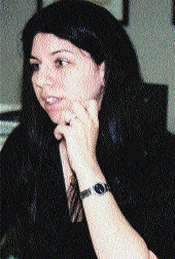 Local
94 employees Renay Carrozza (top, a claims supervisor, and Jillian
Farrugia, a benefits clerical worker, gave comfort to the engineers
who made their way to the union hall on September 11th. Local
94 employees Renay Carrozza (top, a claims supervisor, and Jillian
Farrugia, a benefits clerical worker, gave comfort to the engineers
who made their way to the union hall on September 11th.
As members straggled into their union hall, they were immediately
met by the staff working there. "They just kept coming," said Jillian
Farragia, a Benefits Clerical Worker at the union. "Some were upstairs;
some were downstairs in the engineering building. They came straight
here. They waited .
as more people came. They couldn't believe. They were in shock". .
as more people came. They couldn't believe. They were in shock".
From the moment the news had broken of what was taking place at the
World Trade Center, the phones at the union began to ring. Wives, husbands,
fathers, mothers and children were calling, hoping for news of their
loved one. The Delegates (Union Business Agents) immediately went into
action compiling a list of all missing engineers. Kuba Brown, the Assistant
Business Manager issued directives which brought food into the union
hall and provided private areas for the members to gather and console
each other.
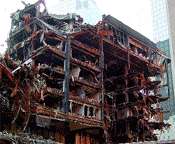 Collateral
damage to buildings adjacent to the World Trade Center was extensive,
resulting in the necessary demolition of several of them. Collateral
damage to buildings adjacent to the World Trade Center was extensive,
resulting in the necessary demolition of several of them.
A list of approximately 150 names was compiled of engineers who had
yet to be found. These were engineers who were seen entering a building
at or near the World Trade Center, but not seen leaving. The Delegates
started phone calling every member who worked in the area to see if
they had seen anyone on the list. Next, delegates fanned out through
the city visiting every triage center, hospital and eventually, every
temporary morgue.
Working throughout the night, by 7 o'clock the next morning, they
had found everyone on the list except four; John Griffin Jr., Charlie
Magee, Vito Deleo and David Williams.
 The
streets of New York were nearly empty except for debris in the hours
following the attack. The
streets of New York were nearly empty except for debris in the hours
following the attack.
In the days that passed, the Union was in mourning for the loss of
her four sons. But other problems began to arise. Problems that could
imperil the Union and would eventually test to the limit, the unity
and leadership of Local 94.
Mike Carney had directed operations with a telephone attached to
his ear for the first several days. When flight restrictions were finally
lifted, he raced to New York.
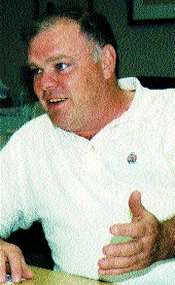 Tom
Costello, a delegate with Local 94, and Arthur J. Orzano (below), Training
Fund Administrator with Local 94, assisted in the search for missing
engineers. Tom
Costello, a delegate with Local 94, and Arthur J. Orzano (below), Training
Fund Administrator with Local 94, assisted in the search for missing
engineers.
Initially confronting Carney was the terrible loss of the four union
members and the need to care for their families not only during their
period of grieving, but into the future as well. A second problem confronting
Carney was that as a consequence of September 11th and the loss of
the 7 buildings that made up the World Trade Center, 150 members of
the Union were effectively without jobs.
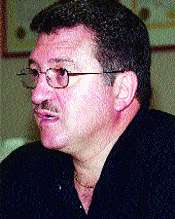
Miraculously, the second problem nearly solved itself. According
to Carney, employers began to call the union hall. "We'll take 3" or "we'll
take 5" the callers would say, referring to the hiring of engineers
left jobless. "I cannot say enough about the employers," Carney said. "From
all over the city, they simply stepped forward, looking for ways to
help".
 Luis
Ramirez was a helper at the World Trade Center. Since the attack he has
yet to find permanent employment. His car has been repossessed and he
is being evicted from his apartment. Luis
Ramirez was a helper at the World Trade Center. Since the attack he has
yet to find permanent employment. His car has been repossessed and he
is being evicted from his apartment.
The first problem was also soon solved. Local 94 is just one Local
Union in the mighty International Union of Operating Engineers. Under
the leadership of the Union's General President, Frank Hanley, local
unions and their combined membership of over 400,000 men and women
from throughout the United States and Canada stepped forward to offer
help, contributions and support. Other organizations and associations
joined in as well. The Chief Engineers Association in Chicago donated
$10,000 to Local 94, for support of their membership and families.
Chicago's IUOE, Local 399, established a fund to help the engineers
and families in New York.
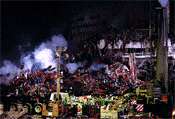 In
the early hours rescue workers combed through the debris in a despaerate
search for survivors. In
the early hours rescue workers combed through the debris in a despaerate
search for survivors.
A third problem encountered, was far more difficult to surmount.
Local 94, like most local unions, provides for the medical insurance
coverage of their membership. They operate, in effect, a small insurance
company for their membership and their members' families.
All insurance companies work on the theory that only a given percentage
of their insured parties will file claims at any given time. So for
example, if everyone who was insured by State Farm Insurance Company,
Allstate Insurance, or any other insurance company were to file an
insurance claim at exactly the same time, these companies may not have
the funds on hand to immediately administer to every claim.
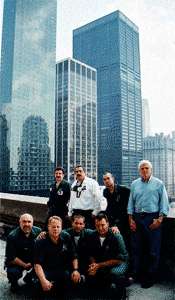 The
Federal Building, adjacent to the World Trade Center site, is presently
being repaired with the able assistance of its Local 94 engineering crew. The
Federal Building, adjacent to the World Trade Center site, is presently
being repaired with the able assistance of its Local 94 engineering crew.
Yet this is exactly what happened to Local 94.
Besides the physical maladies inflicted upon some Stationary Engineers
from the devastation that occurred at the World Trade Center, nearly
every member and each of their family members were traumatized by the
event.
"We had children begging their father or mother to not go to work," said
Tom Hart, Safety Officer at Local 94. "All they knew was that terrorists
had targeted a building and their mother or father worked in a large
building". Wives and husbands of engineers were also showing signs
of traumatic stress. "When I accepted a job downtown," Mike Pecoraro,
a survivor of the World Trade Center told us, "my wife broke down and
started crying. She didn't want me working in another building".
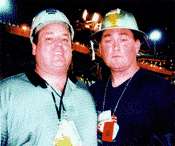 Tom
Hart and Gerald Tate both assisted at Ground Zero in recovery efforts. Tom
Hart and Gerald Tate both assisted at Ground Zero in recovery efforts.
Engineers were also manifesting signs of illness. According to Tom
Hart, some engineers who survived the devastation refused to go back
to work. "They just told us to never call them again. They never want
to work as an Engineer again," Hart said. "Some locked themselves in
their bedrooms, never getting up from bed," he concluded.
Faced with this unprecedented problem, and faced with the staggering
financial liability that confronted the Local Union's health insurance
program, Mike Carney called all the Trustees of the Health and Welfare
department into a meeting.
Once again, Local 94 seemed blessed. The Trustees, comprised of employers
and union members, not only approved coverage for all members, but
they took the nearly unbelievable step of increasing coverage to pay
one-hundred percent of the mental health needs of all members and all
of their family members!
 The
World Trade Center site as seen today. The
World Trade Center site as seen today.
In addition, the New York City Central Labor Council, an affiliate
of the AFL-CIO, stepped forward with trained counselors to offer assistance
to those in need. Paula Daly, a Coordinator with the Labor Rehab Council,
related how on the very night of September 11th, the Central Labor
Council was having telephone lines installed. By morning, 11 lines
were open with a toll free number for a crisis hotline that was established.
Under the leadership of Van Jones and Brian McLaughlin, labor unions
from throughout the East Coast were contacted and came to New York
to help. Offices were constructed and calls were being taken from people
asking for help in finding a family member.
"By the afternoon of the 12th," Paula told us, "we were doing critical
stress debriefing. At every union we got the same response," she related, "which
was: I don't think they can make it over to you, can you come here?" And
according to Paula, that is exactly what they did. Reaching out to
help, the New York Psychological Association and the Institute for
Temporary Psychotherapy provided 100 therapists within 48 hours.
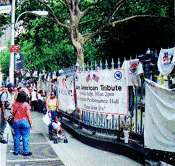 The
fence surrounding St. Paul's Chapel, located adjacent to the World
Trade Center site, has become an impromptu gallery for well-wishers
and visitors to the site. The
fence surrounding St. Paul's Chapel, located adjacent to the World
Trade Center site, has become an impromptu gallery for well-wishers
and visitors to the site.
On September 12th, therapists met with Local 94 members at their
union hall. "It was pretty clear by assessment," Paula said, "that
the gentlemen who had survived September 11th were going to need a
lot of help, emotionally".
Nearly a year had passed when the Chief Engineer visited the men
and women of Local 94 in New York. As we conducted our interviews,
we found that nearly every person we talked with was still in need
of emotional support.
Joe Shearin, who survived the devastation, told us that he still
has the same dream every night. "I wake up in a grave yard, and I am
scrambling through the graves looking for names on the tombstones," he
said
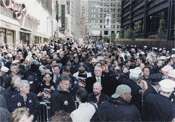 Union
members, fire and police personnel joined together in one of the many
tributes to those lost on Sptember 11th. Union
members, fire and police personnel joined together in one of the many
tributes to those lost on Sptember 11th.
Brian Muller, an operating engineer in charge of 4 World Trade Center,
was outside in the plaza of the World Trade Center when the first plane
struck. "People say they saw bodies," he told us. "To me they were
my tenants; my tenants that I protected for a very long time".
"I wish I could change things in my life," he said, "if I could put
them back like it never happened; in a heartbeat? in a heartbeat".
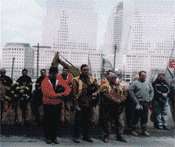 More
than 2,800 lives were lost in the attack on the World Trade Center in
New York. Workers gave silent respect to the remains of each victim found
in the ruins. More
than 2,800 lives were lost in the attack on the World Trade Center in
New York. Workers gave silent respect to the remains of each victim found
in the ruins.
Many we spoke to were still in counseling, private therapy and on
medication to help them cope with the images that still haunt them.
Others, we were told, may begin to experience symptoms in the future
as a form of Post Traumatic Stress Disorder.
 A
special hard hat was used by IUOE members working at the World Trade
Center site. A
special hard hat was used by IUOE members working at the World Trade
Center site.
"We are going to be there for them," said Mike Carney. "Every member;
what ever it takes; no matter how long it takes".
The Future
In the wake of the unprecedented attacks on New York and America on
September 11th, much has changed and more is in the midst of change.
Americans, who for so long relished their right to move freely, must
now adjust to the intermittent challenge to their identity and their
possessions. Chief Engineers and Facility Managers throughout the United
States must now take into consideration the very real threat to their
tenants and properties.
The new federal Department of Homeland Security, State Legislatures
and municipalities are all considering new legislation or policies
aimed at making commercial properties safer. While government progresses,
other organizations and individual property administrators already
have taken steps to improve security and develop emergency plans for
their buildings. What remains to be seen, is if they will learn from
the tragedy of September 11th, 2001 and understand the vital importance
of incorporating facility engineers as a measure of first response.
 From
the beauty of its architecture to the zaniness of inhabitants in Times
Square, New York has always held a spell over Americans and the rest
of the world, as the quintessential great American city. Always maintaining
an aura of wonder and excitement, as well as hope for the millions of
new Americans who arrive there each year, New York will always be America's
City. And the poud men and women of New York's Operating Stationary Engineers
will always be regarded as the people who keep that great city running. From
the beauty of its architecture to the zaniness of inhabitants in Times
Square, New York has always held a spell over Americans and the rest
of the world, as the quintessential great American city. Always maintaining
an aura of wonder and excitement, as well as hope for the millions of
new Americans who arrive there each year, New York will always be America's
City. And the poud men and women of New York's Operating Stationary Engineers
will always be regarded as the people who keep that great city running.
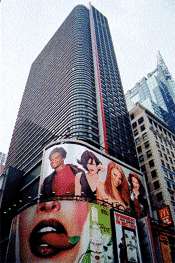
As we were reminded in New York, when the first fireman and the first
policeman arrived on the scene, the stationary engineers were already
there.
The International Union of Operating Engineers seems to be taking
a leadership role in applying the lessons learned from September 11th.
Frank Hanley, the General President of the Union told us: "The senselessness
and cowardliness of the September 11th attacks on the World Trade Center
and the indescribable hurt and sorrow they inflicted on innocent people
will live in my memory forever. I will carry always a feeling of empathy
and sympathy for the victims of those attacks and their families, especially
for those members of the IUOE who perished and their surviving families".
Hanley continued: "I think the actions ? many of them heroic in nature
? of those IUOE members who were working in the complex at the time
of the attacks, including those who died, emphatically drive home the
point that IUOE stationary engineers play critical roles as first-responders
to such tragedies".
In concluding, Hanley told us: "Given that, I intend to re-emphasize
the necessity of the premier training programs the IUOE offers its
stationary engineers, and to expand them to include specific training
as first-responders in the event of tragedy. I also intend to make
certain those powers-that-be in the corporate and government arenas
become cognizant of the exceptional skills and know-how our members
bring to the job, as was evident in the immediate aftermath of the
WTC attacks".
As that union and other property management and owners associations
and organizations gear up for the challenges of the future, the Chief
Engineers will be tasked with the duties of ensuring their staff receives
the necessary training, as well as assuming the leadership role in
any emergency first-response effort at their facility.
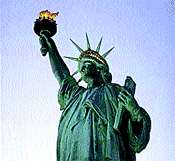
What the men and women of New York went through on September 11th,
2001 will forever remain with us. The quick thinking and hard work
of building engineers was evident in the fact that buildings surrounding
the World Trade Center site were back in complete operation within
hours of the attack. These buildings proved critical to the rescue
and recovery effort mounted at the site.
No sense can ever be made of what happened one year ago in New York.
But we Americans have a 200-year history of overcoming adversity. After
all, that is what America is all about. We are a nation comprised of
people determined to overcome adversity. We are a nation built by people
who came here determined to build better lives for themselves and their
families. We are a nation of new builders, more of whom arrive at our
shores every day. This is the source of our strength. This is the assurance
of our future.
Six plans have been submitted for the rebuilding of the World Trade
Center site. As we learned during our interviews, there will be much
disagreement on which plan will be adopted. Indeed, many feel no rebuilding
should ever be undertaken.
But in the end, we are confident that New York will rebuild the site.
That is what we do here in America.
We build.
Ways You Can Help
The Chief Engineer asked everyone we met and spoke with in
New York how our readers may help. Below are the three suggestions
we obtained and information on how you can help and/or make a difference:
Write a Letter:
Mike Carney, President and Business Manager of IUOE, Local 94, told
us that what is needed most at this time by the men and women of
his local, is perhaps recognition for what they have endured and
what they have accomplished, as well as words of encouragement from
other Stationary Engineers and the American public.
If you or someone you know would like to send a note to the men and
women of Local 94, Mr. Carney will be happy to accept the note and
see to it that the membership of his local union receive it.
Address your cards, letters or notes to:
Mr. Mike Carney
President/Business Manager
International Union of Operating Engineers, Local Union 94
331-337 West 44th Street
New York, New York 10036
Make a Contribution:
Readers who wish to support the recovery and rehabilitation efforts
ongoing in New York may do so by contributing to:
The IUOE Local 94 Disaster Relief Fund
331-337 West 44th Street
New York, New York, 10036
or
The American Red Cross in Greater New York
PO Box 3864
Church Street Station
New York, NY 10008
Get Involved:
As the United States undertakes issues of homeland security, it is
clearly apparent that the safety and security of tenants in commercial,
industrial, institutional and large residential buildings can only
be maintained through the proper training and inclusion of facility
engineers within emergency response plans. If we are to learn anything
from the tragic events of September 11th, it should be the fact that
facility engineers are the first responders to any emergency event
within their facilities.
Let your U.S. Senator, Congressman and State Representatives know that
future plans to safeguard American lives within commercial properties,
must include attention to the men and women who operate and maintain
those properties.
Call or write your representatives.
Editor's Note:
Taking on a story as large as that of the attack on the World Trade
Center was something we admittedly did not give enough consideration
to. Obviously, we are not Time Magazine and certainly do not have the
staff or other resources that would make covering a story of this magnitude
easier than it was. If we had given more consideration to it, we still
would have undertaken the task, but perhaps we would have been more
prepared for all that we encountered and certainly more prepared for
the vast range of emotions we came to experience during our reporting.
That our staff was spending part of each morning describing their various
nightly anxiety attacks became more apparent as our deadline for this
magazine grew nearer. Each day, I, as Editor, was forced to decide
which accounts we would print and which accounts we could not fit into
our tiny magazine. Clearly, this was the hardest of all the decisions
I had to make for this story. During our reporting, we audiotaped over
20 hours of accounts from Engineers and others who were in the World
Trade Center buildings, helped with the rescue or clean-up, or still
work today to assist the survivors and family members of those who
perished. In addition, we filled three notebooks with interviews and
observations and captured 735 photographs.
Every interview we obtained is remarkable. Together, they not only
could fill a book, they undoubtedly will. In the same way that accounts
of the attack on Pearl Harbor are still being published or put on film
today, more than 50 years later, the attack on the World Trade Center
will be written of in accounts published more than 50 years hence.
During the course of that time, the heroics and the suffering of those
we had the honor of meeting will perhaps be brought more fully to light.
For now however, the story is still unfolding, the wounds are to fresh
and the shock still apparent. What was experienced by some that we
interviewed simply cannot yet be related. They witnessed scenes that
no human being should ever have to see or experience. Many who we interviewed
are under the care of physicians and counselors; many are on medication.
All that we interviewed were wounded.
We also found something we never expected within this story. We found
love. The men and women of New York's IUOE Local 94 have such a deep
and abiding love for one another that we were simply left in awe. From
the genuine concern and care shown by Mike Carney, their President
and Business Manager, to every member we spoke to, a bond amongst them
was all too apparent. Forged under the heat of tragedy and tempered
by the care and compassion they have for each other, this bond is such
that we were left certain that in the end, they would together, find
a way to heal each other.
The Chief Engineer gratefully acknowledges the assistance
of the men and women of New York's IUOE Local 94 who allowed us into
their family and assisted us in obtaining interviews with their members.
We are especially grateful to Mike Carney, their president and Thomas
Hart, their Safety Officer who facilitated our visit so well. We also
thank the New York Times, for allowing us the use of a photograph by
Pulitzer Prize winning photographer Vincent Laforet for our front cover.
Most especially, we thank the men and women of Local 94 who gave to
us their time and their trust.
We will never forget.
|
 Mike
Pecoraro helped hundreds to escape only to find himself trapped and staring
death in the face.
Mike
Pecoraro helped hundreds to escape only to find himself trapped and staring
death in the face.
 Joe
Shearin managed to override an overhead garage door mechanism, saving
trapped occupants from certain death.
Joe
Shearin managed to override an overhead garage door mechanism, saving
trapped occupants from certain death.
 Tom
Hart reaches out even today to assist survivors deeply hurt by the World
Trade Center attack.
Tom
Hart reaches out even today to assist survivors deeply hurt by the World
Trade Center attack.
 Mike
Carney, President and Business Manager of IUOE Local 94, continues to
lead his Local through its darkest hour.
Mike
Carney, President and Business Manager of IUOE Local 94, continues to
lead his Local through its darkest hour.
 John
Griffin, Sr. sadly related the final moments of his son's life to the Chief
Engineer.
John
Griffin, Sr. sadly related the final moments of his son's life to the Chief
Engineer.
 September
11, 2001, two hijacked commercial aircraft are flown into the World Trade
Center towers.
September
11, 2001, two hijacked commercial aircraft are flown into the World Trade
Center towers.
 John
McGinley, an Engineer at the WTC was on the 56th floor of Building 2
when the attack occurred. Today he has trouble working in buildings taller
than ten stories.
John
McGinley, an Engineer at the WTC was on the 56th floor of Building 2
when the attack occurred. Today he has trouble working in buildings taller
than ten stories.
 Sergei
Siletzky was a helper at WTC. At the time of the attack, he was attending
class at Local 94.
Sergei
Siletzky was a helper at WTC. At the time of the attack, he was attending
class at Local 94.
 Gerard
Tate, an engineer who rushed to the World Trade Center, discovered trapped
firefighters in the ruins and summoned the help which saved their lives.
Gerard
Tate, an engineer who rushed to the World Trade Center, discovered trapped
firefighters in the ruins and summoned the help which saved their lives.
 Kuba
Brown, Assistant Business Manager of Local 94, directed the union's response
in the initial hours following the World Trade Center attack.
Kuba
Brown, Assistant Business Manager of Local 94, directed the union's response
in the initial hours following the World Trade Center attack.
 Stunned
by the sudden collapse of the towers, survivors made their way to safety
through an enormous dest cloud.
Stunned
by the sudden collapse of the towers, survivors made their way to safety
through an enormous dest cloud.
 James
Berg, who represents employers on the Local 94 Board, came immediately
to the aid of members impacted by the attack.
James
Berg, who represents employers on the Local 94 Board, came immediately
to the aid of members impacted by the attack.
 Peter
Pizzo, an engineer for Lee Technologies near the WTC, laid on his back
on the roof of his building for two and one-half hours keeping condenser
coils from clogging and jeopardizing the hi-tech equipment inside the
facility.
Peter
Pizzo, an engineer for Lee Technologies near the WTC, laid on his back
on the roof of his building for two and one-half hours keeping condenser
coils from clogging and jeopardizing the hi-tech equipment inside the
facility.
 Ralph
Urizzo, an engineer and National Guard member, was activated and sent
to the World Trade Center on September 11th.
Ralph
Urizzo, an engineer and National Guard member, was activated and sent
to the World Trade Center on September 11th.
 Raymond
Macco, Delegate for Local 94, helped to account for some of the 150 engineers
initially missing after the attack.
Raymond
Macco, Delegate for Local 94, helped to account for some of the 150 engineers
initially missing after the attack.
 Brian
Muller, an engineer in Building 4 of the World Trade Center, was left
with deep emotional scars from his experience.
Brian
Muller, an engineer in Building 4 of the World Trade Center, was left
with deep emotional scars from his experience.
 Nicholas
Lanzillotto, Chief Engineer for Merril Lynch at the World Financial Center,
safely evacuated his building then worked 24-hour shifts to bring his
building back into service.
Nicholas
Lanzillotto, Chief Engineer for Merril Lynch at the World Financial Center,
safely evacuated his building then worked 24-hour shifts to bring his
building back into service.
 As
the dust cleared, the full scope of the devastation began to reveal itself.
The loss of police, firefighters and equipment was unprecedented in American
history.
As
the dust cleared, the full scope of the devastation began to reveal itself.
The loss of police, firefighters and equipment was unprecedented in American
history.
 Collateral
damage to buildings adjacent to the World Trade Center was extensive,
resulting in the necessary demolition of several of them.
Collateral
damage to buildings adjacent to the World Trade Center was extensive,
resulting in the necessary demolition of several of them.
 The
streets of New York were nearly empty except for debris in the hours
following the attack.
The
streets of New York were nearly empty except for debris in the hours
following the attack.
 Tom
Costello, a delegate with Local 94, and Arthur J. Orzano (below), Training
Fund Administrator with Local 94, assisted in the search for missing
engineers.
Tom
Costello, a delegate with Local 94, and Arthur J. Orzano (below), Training
Fund Administrator with Local 94, assisted in the search for missing
engineers.
 Luis
Ramirez was a helper at the World Trade Center. Since the attack he has
yet to find permanent employment. His car has been repossessed and he
is being evicted from his apartment.
Luis
Ramirez was a helper at the World Trade Center. Since the attack he has
yet to find permanent employment. His car has been repossessed and he
is being evicted from his apartment.
 In
the early hours rescue workers combed through the debris in a despaerate
search for survivors.
In
the early hours rescue workers combed through the debris in a despaerate
search for survivors.
 The
Federal Building, adjacent to the World Trade Center site, is presently
being repaired with the able assistance of its Local 94 engineering crew.
The
Federal Building, adjacent to the World Trade Center site, is presently
being repaired with the able assistance of its Local 94 engineering crew.
 Tom
Hart and Gerald Tate both assisted at Ground Zero in recovery efforts.
Tom
Hart and Gerald Tate both assisted at Ground Zero in recovery efforts.
 The
World Trade Center site as seen today.
The
World Trade Center site as seen today.
 Union
members, fire and police personnel joined together in one of the many
tributes to those lost on Sptember 11th.
Union
members, fire and police personnel joined together in one of the many
tributes to those lost on Sptember 11th.
 More
than 2,800 lives were lost in the attack on the World Trade Center in
New York. Workers gave silent respect to the remains of each victim found
in the ruins.
More
than 2,800 lives were lost in the attack on the World Trade Center in
New York. Workers gave silent respect to the remains of each victim found
in the ruins.
 A
special hard hat was used by IUOE members working at the World Trade
Center site.
A
special hard hat was used by IUOE members working at the World Trade
Center site.
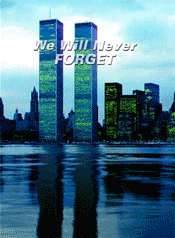
 Paula
Daly works each day to help survivors suffering the emotional trauma
of September 11th.
Paula
Daly works each day to help survivors suffering the emotional trauma
of September 11th.  1993.
Having been through that bombing, Mike recalled seeing similar things
happen to the building's structure. He was convinced a bomb had gone
off in the building. Mike walked through the open doorway and found
two people lying on the floor. One was a female Carpenter and the other
an Elevator Operator. They were both badly burned and injured. Realizing
he had to get help, Mike ascended to the Lobby Level where he met Arti
DelBianco, a member of his work crew. People were now coming down the
same stairway from above the lobby and Arti and Mike had to stay where
they were to direct people out of the stairway door and into the building's
lobby. If they didn't, people descending could walk past the lobby
door and unwittingly keep descending into the sublevels of the building.
1993.
Having been through that bombing, Mike recalled seeing similar things
happen to the building's structure. He was convinced a bomb had gone
off in the building. Mike walked through the open doorway and found
two people lying on the floor. One was a female Carpenter and the other
an Elevator Operator. They were both badly burned and injured. Realizing
he had to get help, Mike ascended to the Lobby Level where he met Arti
DelBianco, a member of his work crew. People were now coming down the
same stairway from above the lobby and Arti and Mike had to stay where
they were to direct people out of the stairway door and into the building's
lobby. If they didn't, people descending could walk past the lobby
door and unwittingly keep descending into the sublevels of the building. Local
94 employees Renay Carrozza (top, a claims supervisor, and Jillian
Farrugia, a benefits clerical worker, gave comfort to the engineers
who made their way to the union hall on September 11th.
Local
94 employees Renay Carrozza (top, a claims supervisor, and Jillian
Farrugia, a benefits clerical worker, gave comfort to the engineers
who made their way to the union hall on September 11th.
 .
as more people came. They couldn't believe. They were in shock".
.
as more people came. They couldn't believe. They were in shock".

 The
fence surrounding St. Paul's Chapel, located adjacent to the World
Trade Center site, has become an impromptu gallery for well-wishers
and visitors to the site.
The
fence surrounding St. Paul's Chapel, located adjacent to the World
Trade Center site, has become an impromptu gallery for well-wishers
and visitors to the site. From
the beauty of its architecture to the zaniness of inhabitants in Times
Square, New York has always held a spell over Americans and the rest
of the world, as the quintessential great American city. Always maintaining
an aura of wonder and excitement, as well as hope for the millions of
new Americans who arrive there each year, New York will always be America's
City. And the poud men and women of New York's Operating Stationary Engineers
will always be regarded as the people who keep that great city running.
From
the beauty of its architecture to the zaniness of inhabitants in Times
Square, New York has always held a spell over Americans and the rest
of the world, as the quintessential great American city. Always maintaining
an aura of wonder and excitement, as well as hope for the millions of
new Americans who arrive there each year, New York will always be America's
City. And the poud men and women of New York's Operating Stationary Engineers
will always be regarded as the people who keep that great city running.

